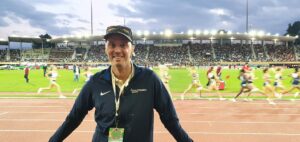In his quality of Editor-in-Chief of the Sport & Exercise Medicine Switzerland (SEMS) Journal, Dr Boris Gojanovic was invited to present his perspective on Sport & Exercise Medicine (SEM) in his home country, Switzerland.

1) Tell us more about yourself
I am a sports medicine physician with training in internal medicine. I work at Hôpital de la Tour in Geneva (Switzerland), I am a SEMS board member and the Editor-in-Chief of SEMS-journal. I was a basketball player for my country in a previous life, and now I look after athletes striving to improve and people seeking better active health alike.

@DrSportSante
2) What is the path to become a sport and exercise physician in Switzerland, and what are the main hurdles on this path?
SEM is not a full specialty in Switzerland, and one must first choose a specialty path. Most SEM doctors are split between general internal medicine, physical medicine and rehabilitation, or orthopaedic surgery. As such, the challenge is to fully train in one specialty and then add the 8 SEMS education modules (20 days) and exams along the way. Additionally, one must work in clinical sports medicine for 6 months, which is difficult due to a lack of training programs. SEM has a very strong clinical focus, and the extra commitments are more happening with clubs and sporting organizations and less in research and academic endeavours.
Academic medicine and its Institutions do not really recognize the place nor the competencies of SEM. Hence they are not addressed in pre-graduate programs. The situation has certainly improved, with better awareness of the importance of sport and exercise in society and the unique position of its medical specialists to help prevent and recover from musculoskeletal problems or facilitate the uptake of regular physical activity for health.
3) How developed is collaborative work in SEM in Switzerland?
SEM traditionally has a strong interdisciplinary culture due to the sports and injury ecosystem: physicians have always been strongly involved pitch-side and understand the necessity to communicate and collaborate with coaching and training staff and the extended rehabilitation team (physiotherapists especially). Over time, SEM has had to face complex issues in sports, like return-to-play, Relative Energy Deficiency in Sport (RED-S), concussions, performance optimization, or fatigue and overtraining. The nature of these issues mandates a team approach, with clear roles for everyone.
Although the awareness of this necessary interdisciplinary approach is increasing, it really functions in pouches here and there. There are multiple reasons for this:
- Lack of time for communication, staff meetings
- Lack of (insurance) reimbursement for the time taken for this additional work
- Lack of reimbursement for key professions like sports psychology and sports nutrition
- Insufficient focus on health in the sporting organization, hence a certain frustration can accumulate when dedicated professionals spend time setting interdisciplinary systems, and the whole thing collapses when a new coach/manager arrives.
- Absence of electronic health record systems in Swiss elite sports. The administrative, technical, financial and cultural hurdles have systematically proven to be too high until now.
Thankfully, many motivated professionals in sport make this teamwork possible, but they need better support from the world of sports.
The same actually goes for physical activity and exercise, with some other aspects contributing to the challenges. The structure and mission of sports clubs do not sufficiently integrate non-competitive programs, and people struggle to find appropriate settings to start exercising for their health. Health/gym clubs present a different challenge: the instructors come from a wide variety of training pathways, and hardly any of them integrate medical aspects.
In my opinion, all professional stakeholders should benefit from training in interdisciplinary work. This invariably requires a good understanding of how “the other profession” thinks and works. I am actually focussing some of my lecturing on these aspects when I interact with other stakeholders.
4) Are exercise physiologists/scientists integrated into your healthcare system, and does health insurance cover for their services?
The honest answer is: no, they are not.
But they (and we) are working on it. Education programs in sports science lead to either a performance training focus or an exercise and health one. This is a great first step, but, unfortunately, the healthcare system does not recognize these qualified trainees and hence does not cover their fees. The only option to recover is within specific rehabilitation programs (e.g., post-myocardial infarction), where a team provides various health prevention and promotion interventions for a flat fee forfeit. They typically happen in medical settings.
When I want to send my overweight, sedentary and hypertensive patient to an exercise specialist to plan for adapted physical activity, the patient must fully finance the service. Some programs with third-party funding (foundations) offer such services, but massive scaling would be necessary to have any chance at a population effect.
5) What is done in Switzerland to promote SEM among students and young professionals regarding research and clinical opportunities?
We realized a few years ago that students had very limited exposure to SEM specialists. Some electives or optional lectures were available, and they have always been highly demanded and rated.
Sport & Exercise Medicine Switzerland supported the creation of a student section within it, Junior SEMS, led by Dr Justin Carrard. Under his leadership and SEMS patronage, very successful (and sustainable) educational events were organized, and many undergraduates could access exposure to our specialty. Contact with universities our ongoing, and there is hope that we can see SEM content integrate the standard curricula in some capacity in the future.
For graduates, we strongly encourage the eager young professionals to engage with their local sporting organizations, volunteer at events and competitions, and tag along with experienced clinicians. Ultimately, it is about seizing the opportunities for interaction, attending symposia and other venues, and create new opportunities.
6) Finally, if you were Harry Potter, what would you change to SEM in Switzerland?
I wish to somehow shift perspective when looking at sport and exercise, especially for youth: trying to move away from a “performance model” to a “health for performance” one. Putting the onus on health is sometimes perceived as overprotective and even naïve in today’s sports reality. I would contend that no sustainable performance is possible without health and that performance should be defined as many different things, of which medals are not the most important. Wellbeing, reduction in non-communicable diseases, recovery of movement and function, active participation in the community and care for the environment are all values that the SEM community shares and promotes.